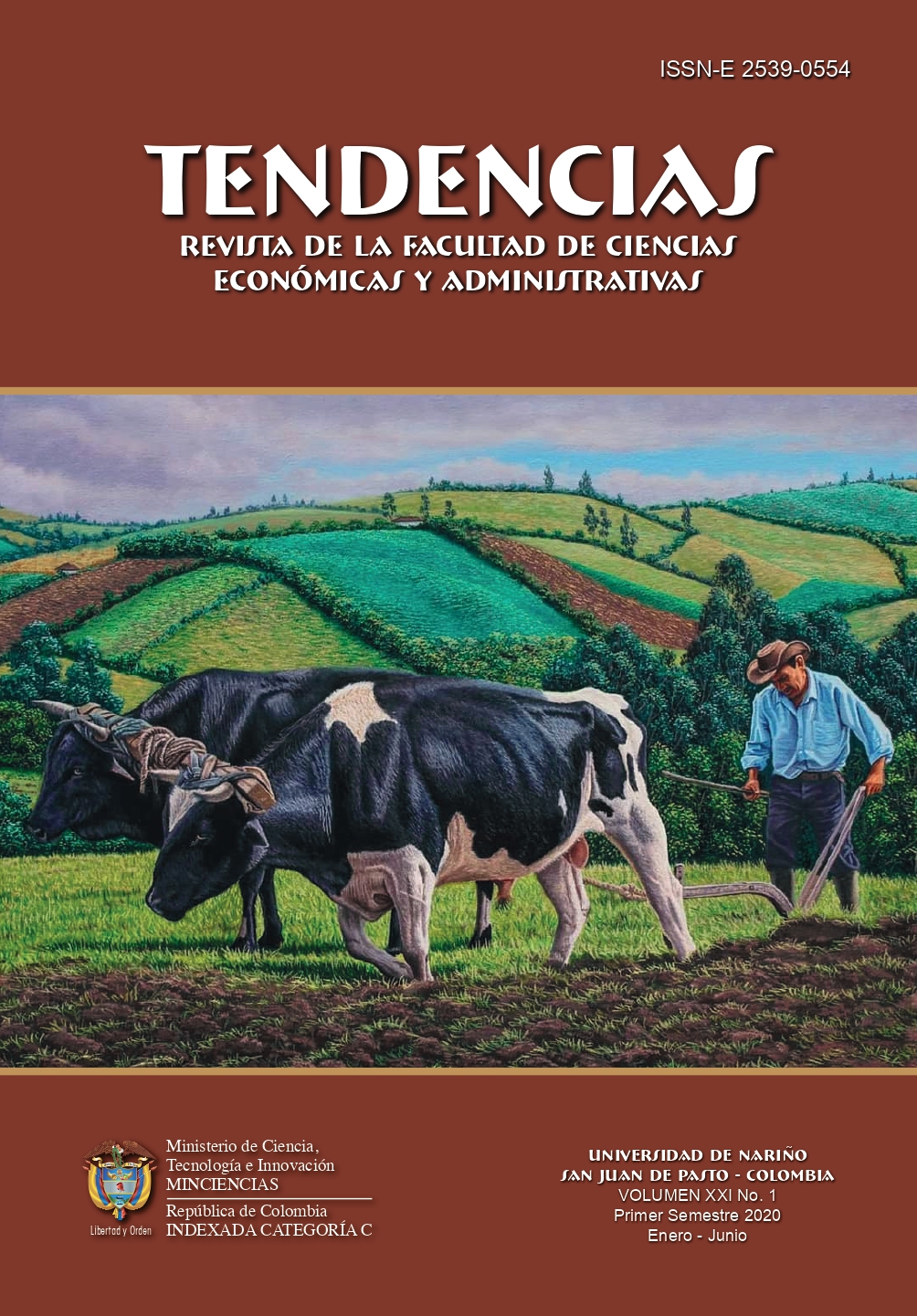Non-conventional monetary policy in the US and behavior of emerging markets in Latin America
DOI:
https://doi.org/10.22267/rtend.202101.126Keywords:
monetary policy, quantitative easing, stock market indices, capital flowsAbstract
This paper intends to determine the incidence of the unconventional monetary policy of the United States implemented since the economic crisis of 2008 on
five emerging markets in Latin America. Therefore, a transmission channel for external shocks was identified, which first affected the return of the stock indices, and then the pass-through to changes in exchange rates was generated due to the expansion in the of foreign capital inflows to countries in form of portfolio investment. The positive response of portfolio investment capital flows to the balance sheet expansions in each of the phases of quantitative easing was
also evidenced through the estimation of panel data models.
Downloads
References
(1) Ahmed, S., y Zlate, A. (2014). Capital flows to emerging market economies: a brave new world? Journal of International Money and Finance, 48, 221-248.
(2) Blancas, A. (2015). Fuga de Capitales en México: análisis y propuesta de medición. Revista Problemas del Desarrollo-UNAM, 24-26.
(3) Bowman, D., Londono, J., y Sapriza, H. (2015). US unconventional monetary policy and transmission to emerging market economies. Journal of International Money and Finance, 55, 27-59.
(4) Calvo, G., y Perry, G. (Marzo de 2015). El Fin de un Cliclo en América Latina y sus Riesgos. Comité Latino Maericano de Asuntos Financieros. Obtenido de http://vox.lacea.org/?q=blog/ciclo-latam-declaracion-claaf
(5) Caruana, J. (2011). El papel de los Bancos Centrales después de la crisis. Bank for Internacional Settlements- Acto Academico OBCE.
(6) CEPAL. (2011). Estudio Económico de América Latina y el Caribe. Publicación de las Naciones Unidas.
(7) CEPAL. (2016). Panorama Social de América Latina 2016. Obtenido de https://www.cepal.org/es/publicaciones/41598-panorama-social-america-latina-2016
(8) CEPAL. (2018). Balance Preliminar de las Economías de América Latina y el Caribe. Comisón Economica para América Latina y el Caribe, 33-38.
(9) Cepalstat. (octubre de 2018). www.interwp.cepal.org. Obtenido de http://interwp.cepal.org/sisgen/SisGen_MuestraFicha.asp?indicador=2207yid_estudio=131
(10) Cepalstat. (octubre de 2018). www.interwp.cepal.org. Obtenido de http://interwp.cepal.org/sisgen/SisGen_MuestraFicha.asp?indicador=2767yid_estudio=812.
(11) Chen, M., Griffoli, M., y Sahay, M. (2014). Spillovers from United States monetary policy on emerging markets: different this time? (No. 14-240). International Monetary Fund.
(12) Dahlhaus, T., y Vasishtha, G. (2014). The impact of US monetary policy normalization on capital flows to emerging-market economies (No. 2014-53). Bank of Canada Working Paper.
(13) De la Torre, A., Beylis, G., y De Piniés, J. (2014). LAC Semiannual Report April 2014: International Flows to Latin America-Rocking the Boat? The World Bank.
(14) Gilchrist, S. (2014). The Response of Sovereign Bond yields to U.S Monetary Policy. Jacques Polak Annual Research Conference.
(15) Hausman, J. (1978). Specification tests in econometrics. Econometrica: Journal of the econometric society.
(16) Irastorza, E., Ullibarri, M., y Arregui, Z. (2010). Un modelo VAR aplicado al empleo y las horas de trabajo. Estadística Española.
(17) Labra, R., y Torrecillas, C. (2014). Guía CERO para datos de panel. Un enfoque práctico. UAM-Accenture Working Papers.
(18) Martin, A., García, V., y Arilla, M. (2010). Crisis Económicas a lo Largo de la Historia . Cuadernos de Formación. Colaboración.
(19) Monsegny, M., y Cuervo, E. (2008). Modelos Arch, garch y EGarch: aplicaciones a series financieras. Cuadernos de Economía, v XXVII, 16-18.
(20) Morales, P. (2014). La eficacia de las políticas monetarias de Quantitative Easing llevadas a cabo por la reserva federal de los Estados Unidos y por el Banco Central Europeo. Universidad Pontificia Comillas ICAI-ICADE. Madrid. Obtenido de https://repositorio.comillas.edu/rest/bitstreams/1087/retrieve
(21) Ocampo, J. (2009). Impactos de la crisis financiera mundial sobre América Latina. Revista cepal .
(22) Ocampo, J. (2009). La crisis económica global: impactos e implicaciones para América Latina. Nueva Sociedad 224, 67.
(23) Orgaz, L., y Carrasco, M. (2011). El creciente peso de las economías emergentes en la economía y gobernanza mundiales: los países BRIC. 52.
(24) Otero, D. (2015). Impacts of monetary policy and transmission channel in Latin-American countries with an inflation targeting scheme. Ensayos sobre POLÍTICA ECONÓMICA 33.SPE76, 75.
(25) Perazzi, J., y Merli, G. (2013). Modelos de regresión de datos panel y su aplicación en la evaluación de impactos de programas sociales. Telos: Revista de Estudios Interdisciplinarios en Ciencias Sociales, 130.
(26) Ramírez, A. y Rodríguez, H. (2013). Un análisis VAR estructural de política monetaria en Colombia. Revista de la Facultad de Ciencias Económicas: Investigación y Reflexión, XXI (2),17-41. Obtenido de https://www.redalyc.org/pdf/909/90930501003.pdf
(27) Ricketts, L. (2011). Quantitative Easing Explaines. Federal Reserve bank of St Louis, 2-8.
(28) Rincón, H. (2013). Flujos de capitales, choques externos y respuestas de política en países emergentes. Obtenido de http://www. banrep. gov. co/libro-flujos-capitales
(29) Rubai, G. (2013). La Generalización del Quantitative Easing y sus repercusiones en la Estabilidad Financiera Global. Instituto Español de Estudios Estrategicos.
(30) Tillmann, P. (2016). Unconventional monetary policy and the spillovers to emerging markets. Journal of International Money and Finance, 66, 136-156.
(31) Toro, J., Mora, R., y Parra, D. (2012). Flujos de capital, la crisis financiera internacional y los desbalances macroeconómicos. Borradores de Economía; No. 720.
(32) Wooldridge, J. (2010). Introduccion a la economía, un enfoque moderno. (4ª. Edición). Mexico. Obtenido de https://www.academia.edu/30200962/Introducción_A_La_Econometría_4edi_Wooldridge
Published
How to Cite
Issue
Section
License
Those authors who have publications with this journal, accept the following terms:
This journal is licensed under a Creative Commons Reconocimiento-NoComercial 4.0 Internacional License. The articles can be copied, distributed, adapted and communicated publicly, as long as the credits of the work are recognized and the respective source is quoted. This work can not be used for commercial purposes.
To increase their visibility, documents are sent to databases and indexing systems.
The content of the items is the responsibility of each author, and does not compromise in any way, journal or institution.







































